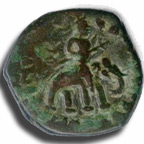History :
Kushan Empire is one of the most interesting Dynasties which ruled over the land of Jammu & Kashmir. The Kushans ruled from first to second century AD, extending its reach to each and every corner of the valley. The chapter of Kushan Empire is truly a glorious one in the Jammu & Kashmir history. During the reign of Kushans in Jammu Kashmir the influence of Buddhism was at its peak. Later the Kushans attained predominance over the other and the leader was Kadphises. And then began the history of Kushans.

The successor of Kadphises was Vima Kadphsis who conquered large parts of North India. The coins of Kadphises show that his authority extended upto Banaras and also till Indus basin. The valour of this king extended from Narmada to Saka Satraps in Malwa and Western India acknowledged his sovereignty.

The conclusions of Kaniskha council were engraved on copper sheets and preserved in the stupa of the capital. Delegates to the council primarily belonged to the Hinayana sect. Soon the Kushan power declined. Within the Kingdom Nagas and Yaudheyas troubled Kushans. During the period of Kushan Dynast,y Naga ruler probably performed ten ashvamedha sacrifices and few other tribes also like Malavas and Kunindas probably regained their importance at the expense of Kushan kings. Brisk trade prevailed as the area covered by the Kushan Empire helped the flow of trade between the east and the west.

Place |
Jammu & Kashmir |
Period |
200 BC- 300 BC |
Language |
Pali Prakrit Bactrian Sanskrit Greek |
Religion |
Buddhism, Hinduism, Zoroastrianism, Greco-Buddhism Ancient Greek religion |
Kings |
Kujula Kadphises, Vima Taktu or Sadashkana, Vima Kadphises, Kanishka I, Huvishka, Vasudeva I
|
Gold coins issued by the Kushans were of great complexity . The coins speak about the prosperity of people and show the figure of Kanishka standing and sacrificing at altar and deities belonging to various religions. The coins also signify that Kushans were in direct contact with the Romans. The greatest contribution of Kushan Dynasty was Gandhara art. Stone images of the Buddha and Bodhisattavas were carved out and the chief feature was blending of Buddhist subjects with Greek forms.
It was quite commendable that effectiveness and efficiency with which the Kushan Rulers dictated the land of Jammu & Kashmir. The multi-dimensional importance of this Dynasty is described by the historical archives. In fact the imprints of Kushan Dynasty are still found in Jammu & Kashmir in the form of names.
Huvishka ascended the throne of Kanishka I. He was founder of a city Hushka in Kashmir named after him (described by Kalhan in Rajatarangini). During Kanishka's and Huvishka's reign the Kushana Empire was at its zenith. After Huvishka's reign, Vasudeva I took over the control of Kushana dynasty which by then had lost control over regions beyond Bactria or perhaps the Bactria itself. The Kushan dynasty had been totally assimilated in Indian culture. Vasudeva I was the last greatest king of the dynasty when Kushana empire was at it's height of splendor and prosperity.

Administration & Society
Kushans were turbulent tribes in ancient India after confronting the several obstacles. The empire extending its limit not only in India but also in central Asia. The dynasty had vibrant rulers and India attained thriving progress in the fields of Art, Literature, Architecture and sciences.The Kushan Dynasty kings generally gave titles such as Maharajati-raja(king of kings), Daivaputra(son of heaven), soter(savior) and Kaisara(Caesar).During Kushan Dynasty four schools of art namely Sarnath, Mathura, Amaravati and Gandhara developed. The headless statue of Kaniskha is the epitome for the sculpturous art.


